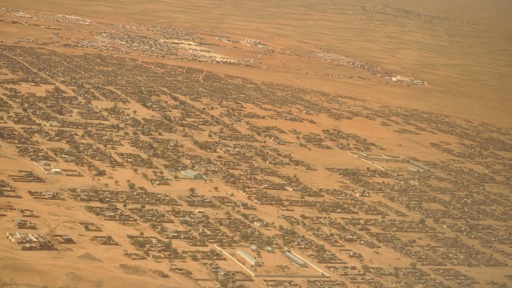Massacring thousands in North Darfur’s capital, El Fasher – a city it had besieged and starved for over 500 days – Sudan’s Rapid Support Forces (RSF) left behind bloodied patches of soil large enough to be visible from space.
Satellite photographs of El Fasher after the RSF’s invasion on October 26 show several areas of its land with a reddish discoloration, not observed in prior images.
Many of these colored patches are also strewn with “objects” measuring “approximately 1.3 – 2.0 meters, which is the expected range of a human body of average height lying horizontally,” said a report by Yale Humanitarian Research Lab (HRL) on October 28. Gun-mounted RSF vehicles are also visible in the satellite images at these locations.
This combination of red coloration, human-sized objects, and RSF vehicles is seen at several locations near the 57-km wall that the RSF constructed to totalize its siege and stop the little food that was being smuggled in.
“It is highly likely that the phenomena seen in satellite imagery is consistent with RSF rounding up and killing people trying to flee El-Fasher,” the report explained.
Bodies are also visible on the grounds of the Red Crescent office in El Fasher, stormed by the RSF, whose troops reportedly forced its medics into their combat vehicles.
Another cluster of objects, consistent with dead bodies, lay strewn “from the building to the gate” of a former children’s hospital that had stopped functioning a year ago. The RSF had turned the building into a detention center.
Two more clusters of bodies have also been observed on the blood-soaked grounds “located approximately 75 meters west of the Saudi Hospital” – the last hospital that was still functioning in the besieged city. RSF troops rounded up wounded and sick patients, and executed over 460 people, the WHO said.
The death toll is difficult to estimate amid the communications blackout and lack of physical access. The Sudan War Monitor estimated 3,000 deaths as of October 30.
“Individuals on the ground sent a message that reached us Monday morning that 1,200 were dead,” said Yale HRL’s executive director Nathaniel Raymond. “By that evening, they said 10,000. By Tuesday, we couldn’t reach them anymore. We assume our ground contacts are dead,” he added.
The UN had estimated that 260,000 civilians were trapped in the city before the RSF overran it. According to the Resistance Committees of El Fasher, most of the civilians who were unable to flee the city have been killed. The lives of those who managed to escape also hang in the balance, as there is little food and medical care to cater to the starving and wounded.
“We have also received alarming reports of sexual violence,” the spokesperson for the UN High Commissioner for Human Rights said on Friday, October 31. “Humanitarian partners reported that at least 25 women were gang-raped when RSF forces entered a shelter for displaced people near El Fasher University. Witnesses confirm RSF personnel selected women and girls and raped them at gunpoint, forcing the remaining displaced persons – around 100 families – to leave the location amid shooting and intimidation of older residents.”
“Can anyone here say that we did not know this was coming?” asked UN Under-Secretary-General for Humanitarian Affairs Tom Fletcher. “As we sit here today, the horror is continuing. Women and girls are being raped, people mutilated and killed – with utter impunity,” he added in his briefing to the ambassadors in the UN Security Council.
“I urge colleagues to study the latest satellite imagery of El Fasher; blood on the sand. And I urge colleagues to study the world’s continued failure to stop this. Blood on… [our] hands.”
The post A bloodbath visible from space: RSF’s massacres in Sudan’s El Fasher appeared first on Peoples Dispatch.
From Peoples Dispatch via this RSS feed


